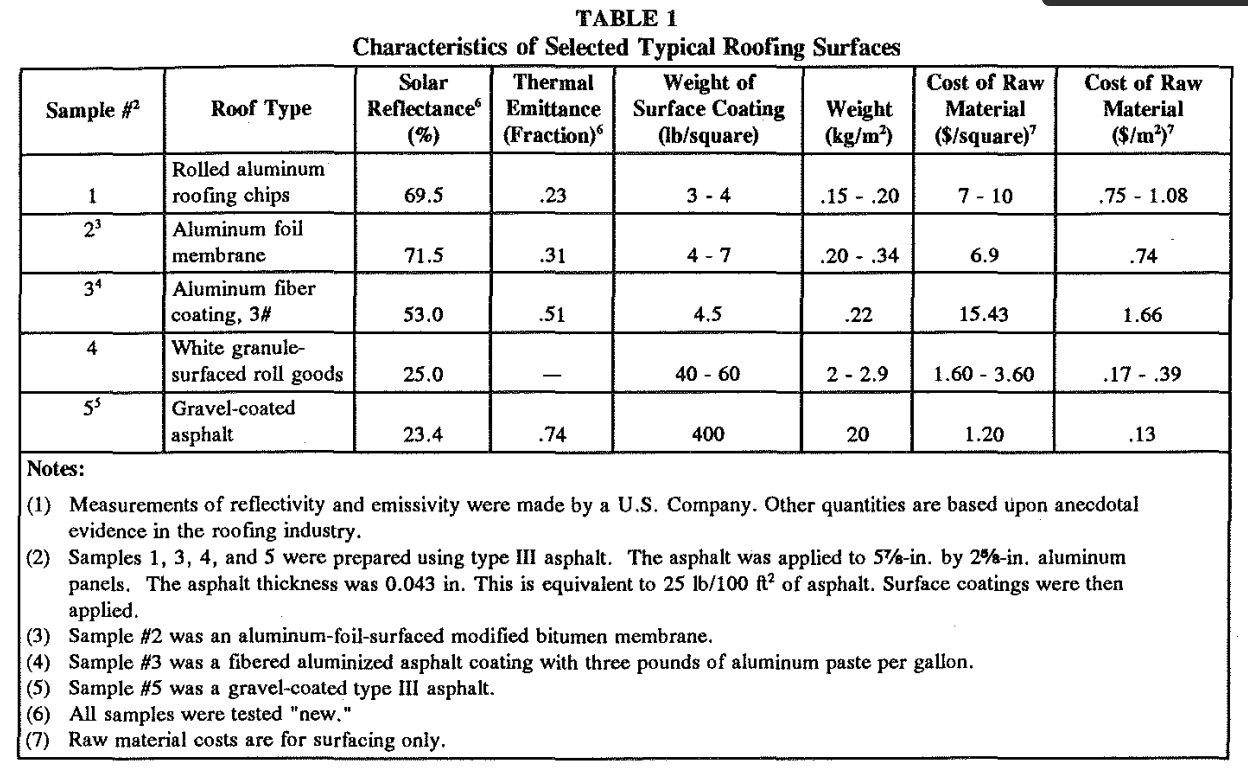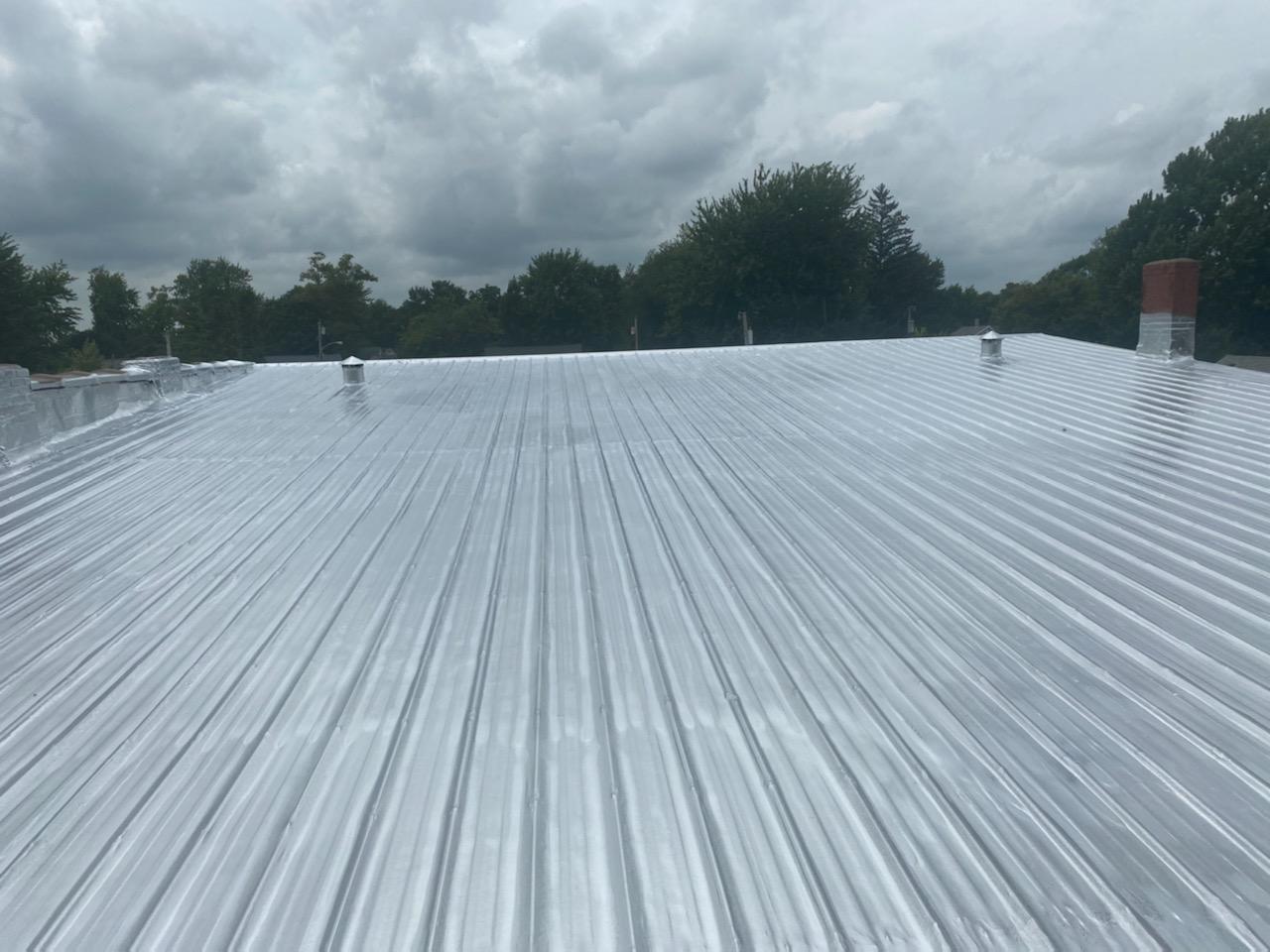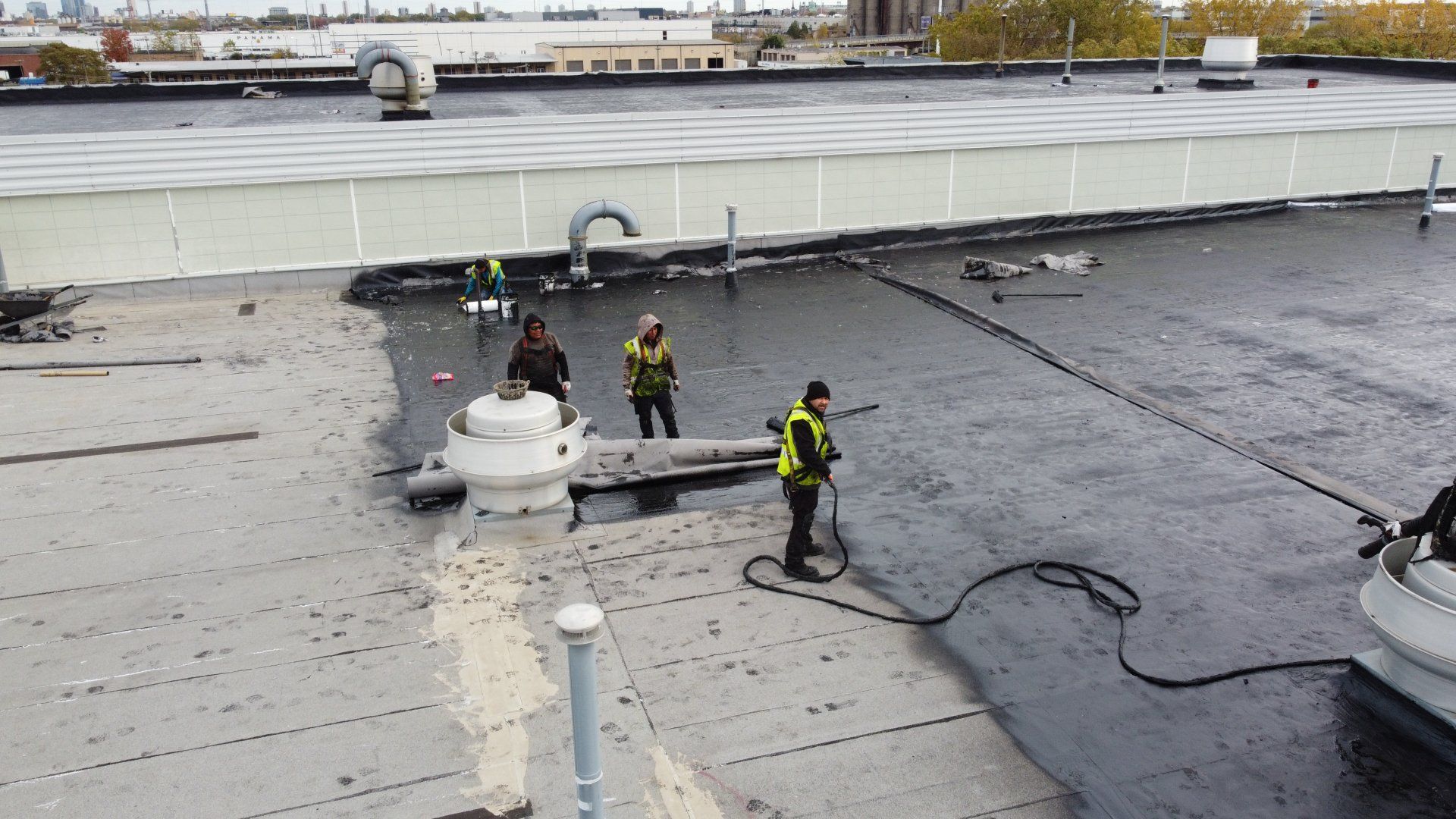Application and Experience in the Use of Aluminum Chips as a Reflective Surface for Commercial Roofing
ABSTRACT
The idea of using thin aluminum chips as a reflective surface for commercial roofing was first introduced 10
years ago. Chips for commercial roofing applications are approximately 40 by 60 by 1.3 mils (1.016 by 1.524 by .033
mm) in size and are applied to roofing surfaces at an intensity of about three to four pounds (1.36 to 1.82 kg) per
square (100 fr [9.29 m2}). Chips can be field or factory applied.
Solar reflectivity measurements indicate that approximately 70% of the full solar spectrum is reflected. After
accelerated weathering tests according to ASTM G90 equivalent to 10 years of exposure, more than 96% of the
original reflectivity is retained. Aluminum chip surface have an additional advantage in that they reflect the
ultraviolet solar rays and reduce the roof temperature. Accordingly, the roof life may be prolonged significantly.
Since 1984 more than 25 million ft2 (2.32 million m2) of aluminum-chip roof surface have been installed. A brief
review of the early roofing projects indicates that retained reflectivity and extended roof life are being achieved.
The purpose of this paper is to describe briefly the characteristics of such roofing surface how the product is
applied to roofs, and the experience to date in their application and performance.
INTRODUCTION
It is well established that roofs are often more exposed to climatic conditions than the other exterior elements of a building. Ordinarily, roof membranes are not protected by adjoining buildings and are generally exposed to the full effect of wind, precipitation, temperature variations, and sunlight. The final waterproof coating of a built-up roofing membrane is usually a comparatively thin layer, such as emulsion coating or acrylic coating. To complete its weathering and wearing qualities, some additional surface protection is typically provided, such as liquid-applied reflective or non-reflective surface coatings, aggregate surfacing, or mineral surface cap sheets (Tibbetts and Baker 1965).
Suitable surfacing will protect bitumen from sunlight and prevent excessive surface temperatures. Reflective coatings, metal foil, concrete pavers (PMR system), and mineral aggregates have been used for this purpose. All have advantages and disadvantages in terms of cost of installation, total costs benefit, life, reflectivity, weather-ability, and fire resistance.
The idea of using thin aluminum chips as a reflective surface for commercial roofing was first put forth about 10 years ago. These small thin aluminum flakes (roofing chips) approximately 40 by 60 by 1.3 mils (1.016 by 1.524 by .033 mm) in size are made in a proprietary process involving rapid solidification of small streams of liquid metal. The chips are applied to fresh, tacky bitumen surfaces at an intensity of about three to four pounds (1.36 to 1.82 kg) per square (100 ft2 [9.29 m2]).
CHARACTERISTICS OF ALUMINUM·CHIP ROOFING SURFACES
Reflectivity and Emissivity
The major desirable characteristics of aluminum chips are their reflectivity and emissivity as a roofing surface. These values are shown in Table 1 for new surfaces compared to samples of other typical new roof surfaces. It will be noted that about 70 % of the solar energy is reflected compared to about 23 % for new granule-coated asphalt and 56 % for a new fibrated-aluminum coating. Similarly, the infrared emittance of the aluminum flakes at room temperature was measured at E = 0.23, which compares to 0.51 for the fibrated-aluminum coating and .74 for the granule-coated asphalt.
WEIGHT PER UNIT AREA
The weight of a surface coating on a roof is of secondary importance but does enter into the intangible factors of cost in terms of shipping costs from the plant to the roof and the labor costs of spreading material over the roof surface.
The normal weight per square (100 ft2 [9.29 m2 ]) of roofing surface for aluminum chip applications is three to four pounds (1.36 to 1.82 kg) depending upon the applicator's practice for site-applied material or factory-applied roll goods.
Table 1 is a comparison of the weight per square of aluminum chips with the other typical roofing surfaces.

As might be expected, it constitutes on of the lightest roofing surfaces in terms of weight.
Thermal Performace
The use of aluminum chips on a roofing surface affects both the amount of heat transferred to or from the building and the actual surface temperature of the roof (Talbert 1982). Empirical data were not available to compare the thermal performance of typical roof systems with various surfaces and aluminum chip surfaces. However, heat flow calculations have been made based upon an energy balance equation for a typical roof surface (Talbert 1982).
Calculations of the magnitude of these effects are heavily dependent upon the region of the country, the wind, and the R-value of the roof system. The following calculated results are indicative only of the effects that might be expected under solar conditions typical of the Phoenix, Arizona, and Atlanta, Georgia, regions (Talbert 1982).
The high reflectance of aluminum roofing chips primarily affects the heat flow through the roof during daytime conditions in the summer, since winter day and night conditions tend to counterbalance each other (i.e., the low emittance saves energy at night, but solar energy is reflected in the day rather than being absorbed by the roof). For example, the aluminum roofing chips are expected to reduce the peak design cooling loads of a typical roof by up to 45% on a sunny July day, which could result in a savings of about $2.80 per square during the first cooling season. Over 20 years, counting energy savings, re-coating costs, escalation, etc., based upon the heat flow calculations, it has been estimated that the total savings over a dark roof are about $100 per square. These savings do not count the savings in capital investment through the downsizing of the air-conditioning equipment because of the reduced cooling load.
The other major benefit of the highly reflective surface of aluminum chips is that the peak surface temperature of the roof is substantially lowered. For example, with a standard R-value of lO h·ft·'F/Btu (5.78 W/[m·K]), the calculated peak roof temperature is reduced from 144 OF to 118'F (62'C to 48'C) in a 7.5-mph wind or from 202'F to 168'F (94'C to 76'C) with no wind (Talbert 1982). There is a rule of thumb that a rise of temperature of 18 'F (lO'C) roughly doubles an organic material's rate of deterioration (Baker 1980). Thus, it is not unreasonable to expect that aluminum chip roofing surfaces should extend the service life of a roof.
In addition to these effects, the use of aluminum chips is expected to result in slower rates of "alligatoring," slower blister growth, and reduced risk of membrane slippage (Griffin 1980).
APPLICATION PRACTICE AND EXPERIENCE WITH ALUMINUM CHIP ROOFING SURFACES TO DATE
Aluminum chip roofing surfaces were first introduced commercially in 1984. Since then, more than 25 million ft²
(2.32 million m²) of aluminum chip roof surfaces have been installed. Both site-applied and factory-applied surfaces are currently being utilized. This section is a brief report on the experience to date.
Site-Applied Installation
Site-applied installation of aluminum chips is done over solvent-based, cold-process asphalt coatings. The application is performed using a gas-powered backpack blower that dispenses aluminum chips at a coverage rate of three to four pounds (1. 36 to 1. 82 kg) per square. The slow set time of cold-process coatings permits considerable latitude in timing the application of the aluminum chips. The light weight of the aluminum chips can be a drawback in certain situations, such as high wind conditions, but in most cases, any excess chips can be redirected onto the wet asphaltic coatings with the backpack blower/dispenser.
Aluminum chips are not field-applied directly to hot asphalt because the proper temperature for hot asphalt application is too high for chip application. The temperature range for proper application and adhesion of the aluminum chips is between 275°F and 350°F (135°C and 177°C). If the temperature of the asphalt is too high, the chips sink beneath the surface. If the temperature of the asphalt is too low, the surface skims over and the chips do not adhere at all. The difference between these two conditions provides a temperature "time window" that is too short and uncontrollable for practical roofing installations. This is not a problem with cold-process roofing.
Factory-Applied Aluminum Chip Surface Products
Factory applications of aluminum chips to rolled roofing materials are gaining increasing acceptance. The chips are applied to the surface of cap sheet or modified bitumens in the same manner in which granules are applied. In most cases, only minor adjustments to the manufacturer's granule equipment are needed to account for the different flow properties of chips compared to granules. Diffusion screens or rotating beater bars placed between the applicator and the moving membrane even out the application of the chips to the surface. Factory control of membrane surface temperature, product line speed, and chip application rate results in a very uniform, properly adhered aluminum-chip surfaced roofing sheet.
To date, the primary factory product using aluminum chips has been styrene butadiene styrene (SBS) modified bitumen cap sheets. These products are used in so-called "modified bitumen applications" and as an SBS-modified top sheet for built-up roofs (BUR).
The modified bitumen cap sheets are installed in the same fashion as granule-surface sheets, using hot asphalt or cold-process adhesives. These installation methods are familiar to most cap sheet applicators and should require no deviation from accepted roofing practices. Individual manufacturers of aluminum-chip-surfaced modified bitumen cap sheets may have slight variations in recommended installation techniques based on warranty requirements and regional climatic conditions.
The fire retardancy of aluminum chip roofing surfaces depends upon the fire-retardant properties of the material to which they are adhered. Manufacturers whose granule surface roofing products carry a fire rating can achieve the same rating for their aluminum-chip-surfaced products.
Accelerated aging tests according to ASTM G90 have shown negligible deterioration of the reflectivity and emissivity properties of aluminum chip surfaces. Visual inspection of older aluminum chip roofs indicates essentially no deterioration of roof surfaces after six to eight years of life. However, no physical or chemical testing on samples has been done to quantitatively verify this observation.
Conclusion
Although aluminum-chip-surfaced roofs are not yet a significant share of the total commercial roofing market, their use is steadily growing both in the United States and abroad. Roofing applications include schools in Singapore and Oregon, villas in Bahrain, and factories in the United Kingdom as well as all parts of the United States.
Using standard heat transfer relationships, as was done in the above examples, it is readily apparent that a highly reflective roof such as is obtained with aluminum chips may be cost-effective for the owner. These considerations will certainly enter into the decisions concerning the type of roof surface to be specified. However, from a national conservation consideration, the aggregate of energy and petroleum savings can be equally impressive.
References
Baker, M.C. 1980. Roofs, p. 120. Quebec, ON: Multiscience Publications Ltd.
Griffin, P.E. 1980. Cost savings with heat-reflective roof coatings. Plant Engineering, July 10, File #5015.
Talbert, S.G.1982. Summary report on energy savings of buildings using aluminum roof flakes. Columbus, OH: Battelle Columbus Laboratories.
Tibbetts, D.C., and M.C. Baker. 1965. Mineral aggregate roof sUrfacing. Ottawa: CBD65.

USEFUL LINKS
BUSINESS HOURS
- Mon - Fri
- -
- Sat - Sun
- Closed


